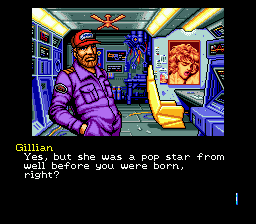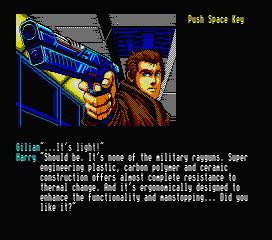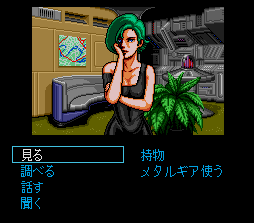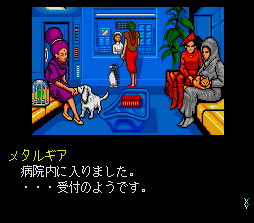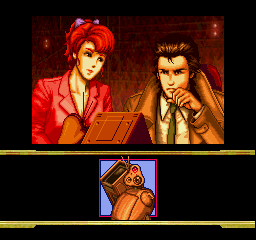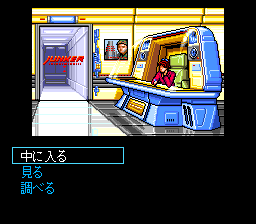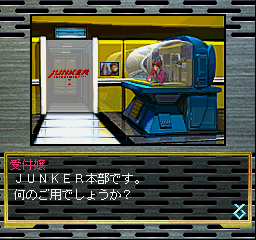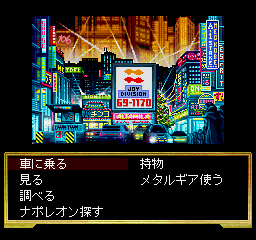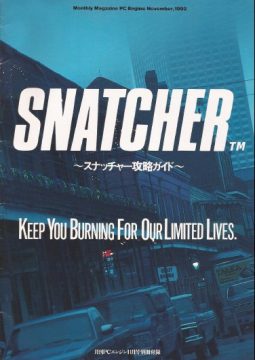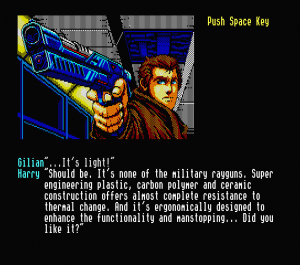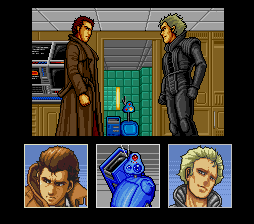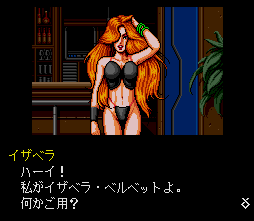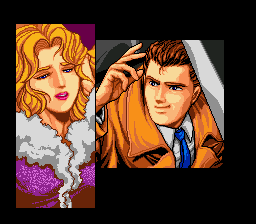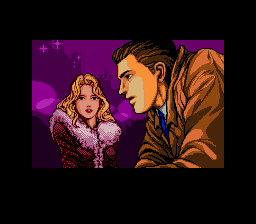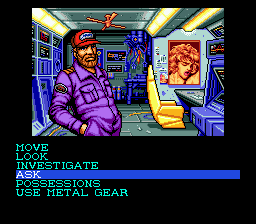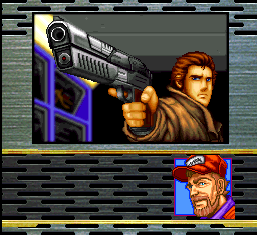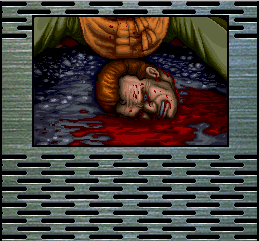- Snatcher
- SD Snatcher
Sega CD fans never had much to be happy about, unless you caught some sort of rare virus allowing you to enjoy such Digital Pictures gems as Sewer Shark and Double Switch. In the waning days of the Sega CD, Konami decided to do an exclusive port of their classic cyberpunk adventure Snatcher in hopes that American audiences would dig up the extraordinarily cool characters and storyline. Popular in Japan, Snatcher was the creation of Metal Gear creator Hideo Kojima, but it was more in line with a PC-style adventure game. Unfortunately, when it finally came out, it was saddled with no exposure and carried a Mature rating – something retailers were not happy with after Mortal Kombat and other violent games got notice in Senate hearings. As such, the game flopped miserably, and it only remains in the hearts of the hardcore – but despite its rather linear and direct nature, Snatcher remains one of the most engrossing video games ever created.
Snatcher begins on an uplifting note – one third of the world’s population was wiped out due to the outbreak of a mysterious virus. Fifty years later, a strange life form mysteriously appears out of nowhere in the city of Neo Kobe, thus beginning the core story. These robotic beings, which look like the exoskeletons from the Terminator movies, disguise themselves as humans and kidnap (known as “snatching”) high-ranking people, taking their place in society. An operation known as JUNKER is set up to combat the Snatchers, to find out where they came from, what their ultimate purpose is, and how it connects to the global catastrophe that destroyed so much of the Earth.
Characters
Gillian Seed
The protagonist, he’s a bit of lech, but has a good heart. He was discovered in cryogenic sleep somewhere in Siberia, with no recollection of his past. Recalling only vaguely the word “Snatcher”, he becomes a JUNKER in hopes of recovering his memory.
Metal Gear Mk.2
A miniaturized version of the Metal Gear robot from Kojima’s other series. The events of the Metal Gears, at least the MSX2 games, are apparently (somewhat) canon in the Snatcher universe. He’s small and unarmed, but has a videophone function, and has a good rapport with Gillian, often straightening him out from his meandering ways. When he’s introduced, the game plays the theme music from the original MSX2 Metal Gear.
Jamie Seed
Gillian’s wife, apparently. They were discovered together in Siberia, but since neither remembers one another, they decide to separate until they can sort out their pasts.
Benson Cunningham
The chief of JUNKER. He does little outside of sitting in his office and explaining your responsibilities, occasionally offering some exposition.
Harry Benson
The engineer at JUNKER H.Q. He’s a bit of a drunk, but he’s the genius behind Metal Gear. Plus, he hooks you up with your gun, so he’s a cool guy.
Mika Slayton
The secretary at JUNKER H.Q. At first she’s put off by Gillian’s advances, but she comes to admire him, eventually.
Katrina Gibson
Jean Jack’s teenage daughter is naturally distraught over her father’s death, so she does all that she can to help Gillian’s investigation. Despite her official artwork showing her with brown hair, she has blue hair in game.
Isabella Velvet
A dancer at the club Outer Heaven. You get to drill her (for information) but otherwise isn’t terribly important. She’s featured in a lot of artwork for her obvious assets.
When Gillian arrives at Junker HQ, you actually get to take control of the action. After getting introduced to your co-workers and issued your gun, you get assigned a cute little robot navigator named Metal Gear, based off one of Kojima’s other games that you may have heard of. While this minature robot doesn’t have any weapons, it acts as a storage unit for graphical data, operates as a video phone, and also saves your game.
After the initial setup, Snatcher wastes no time in getting to the action. You receive an emergency call from fellow JUNKER Jean-Jack Gibson, who thinks he found some bad guys in a deserted factory. Gillian arrives there just in time to find poor Jean with his head twisted off. Following the leads left behind by his dead predecessor, Gillian attempts to uncover the Snatchers and their undoubtedly horrible secret. The whole story unfolds over the total of three “acts”.
Rather than the point n’ click interface of many adventure games, everything in Snatcher is operated through menus. Basic commands such as Look, Investigate and Move are almost always available, plus you can go into your Possessions menu to use various items. It eliminates the pixel-hunting usually associated with games like this, but it brings up another awkward problem – you usually have to constantly select different options until you trigger a plot event. If you have a door in front of you, you can’t just try to open it. You have to look at it, investigate, knock, and shout until your characters actually decide to do something. There isn’t even a “pick up” command – you get objects by repeatedly looking/investigating them until Gillian decides to take it. There aren’t even very many puzzles in the game, just lots of investigating.
This is pretty standard for Japanese adventure games of the 1980s and 90s, which evolved from the Famicom port of Enix’s Portopia Renzoku Satsujin Jiken. But it also feels much more restrictive compared to Western adventure games like King’s Quest or The Secret of Monkey Island, which had third person perspectives and let you freely walk around the environments.
The subtitle for the Japanese PC Engine version of Snatcher is “CDROMantic”, combining “CD-ROM” with “romantic” (in the adventure sense and not the love story sense.) For a long time, Snatcher was one of the only Japanese-style adventure game released in America, although the popularity of similar games like Hotel Dusk and Phoenix Wright for the DS, released more than a decade after Snatcher, helped pushed the genre in America.
There those that still argue that storylines and plots have no place in video games – if they wanted one of those, they’d read a book. Snatcher does an excellent job of disproving that. It tells an interesting story, despite its obvious ripoffs and contrivances, which is largely forgivable just to how well everything is presented. There’s a lot of extraneous background information, found both in the locations and inside the computer’s database, which help to build up the game world. None of it is essential, but keeping it optional helps the player control the pacing of the game, rather than it being force fed like oh-so-many overly wordy novels. The ability to the control the action gives an extra connection to the main character – any comment towards Gillian becomes a comment towards the player, and then elicits their own emotional response. The fantastic graphics, the consistently marvelous soundtrack, the high quality writing and voice acting, all work together to create something quite unlike any media.
Part of what makes the game so interesting the chemistry between Gillian and Metal Gear. They’re not exactly the cliched odd couple – while Gillian is mostly prone to fooling around as Metal Gear remains on business, they get into amusing arguments and random tangents during their investigation. Their banter is not only highly amusing, but goes so far as to make them seem real. Even more stunning the relationship between Gillian and his ex-wife Jamie. You can call her up at any time in the game to converse, but even as Gillian jokingly flirts with her, you can detect his sorrow as he awkwardly tries to be involved the woman he apparently once loved.
Snatcher also has elements of a long lost artform – the radio drama. Since so much of the game consists of still graphics, much of the emotion is conveyed through the voice acting and sound effects. Of course, the main reason all of this comes off so well is that Konami really put forward one of the best localizations in video game history. The text is extremely well written and is surprisingly well-tailored to English. And while so many American companies were hiring talentless hacks for their voice work, Konami hired some outstanding actors for every character in the game. When Gillian and Metal Gear attempt to enter an apartment, then Metal’s sirens start blaring, and the awesome “danger” music (“Pleasure of Tension”) cuts in, and the two share a few quick words before bursting into the scene. You see stuff like this all the time in movies and comics, but yet somehow, it feels remarkably different, and even more effective. It’s impressive just because how low tech it is – this all consists of a few still visuals and some well timed sound work.
Of course, there are some odd things with the plot you just have to forgive. For example, if the Snatcher menace is so huge, then why is Gillian the only active JUNKER through the entire game? One of the game’s most crucial plot points is kind of ruined when the game is played in English – it’s much more obfuscated in Japanese lettering, which is something that probably should’ve been altered during localization. And of course, you have to be willing to forgive Kojima for using the old “amnesiac” trope to create a backstory, and while parts of it are predictable, others still remaining genuinely surprising.
In an attempt to add a bit of action to the game, there are a few shooting scenes interspersed throughout. Playing with the control pad is very easy, as there is a 3×3 grid for you to target your cursor. The real fun starts if you’re playing the Sega CD version and have the Justifier light gun that came with Lethal Enforcers. It really adds to the atmosphere when you get into a dangerous area, have to throw down your controller and pick up the Justifier to shoot at whatever baddies may approach.
It’s not only the characters, but it’s the atmosphere where Snatcher comes off so well. Neo Kobe city and its characters are all astoundingly well realized. While each location is rarely more than a simple static screen with some minor animations, the writing brings everything to life – each little nook and cranny will uncover something new and interesting about this future. The background of the world is further fleshed out by reading all of the historical documents found in the JUNKER supercomputer, which shows how much effort was put into making Snatcher a truly engrossing experience.
Other than the interface, and perhaps the inability to skip through the voiced dialogue segment, the only problem may be its length and lack of difficulty. Since there isn’t really much in the way of traditional puzzles, you can get through the game without any help in about six hours. Furthermore, the linear nature doesn’t exactly lend itself to replayability, but like a good novel or movie, it’s worth revisiting over and over down the road.
Like much of Kojima’s work, Snatcher takes inspiration from several sci-fi movies. The city and basic plotline is straight out of Blade Runner (the intro even includes flames shooting out of buildings), the design of the Snatchers is obviously straight out of The Terminator, and there’s obviously a huge influence from Invasion of the Body Snatchers. Plus, bounty hunter Random Hajile looks astoundingly similar to both Sting’s Feyd-Rautha Harkonnen from Dune, and there’s a snatcher that looks just like Rutger Hauer’s Roy Batty from Blade Runner. The Snatcher’s ability to shoot projectiles from its mouth also seems to have been lifted from the classic anime series Bubblegum Crisis.
Snatcher was originally released in 1988 on disk format for both the MSX2 and PC8801. The MSX2 version was fan translated into Portugese and English. The visuals occupying a small window less than a quarter of the size of the screen, limited to 16 colors. The commands appear to the right, and are activated by hitting numbers. The interface is a bit of a pain, because it’s inconsistent and riddled with useless commands. Both versions are essentially identical, although the MSX2 version gives the option for either PSG sound, or enhanced music with the SCC cartridge, while the PC-88 version uses FM synth. It’s the only version where the characters’ lips actually move when they talk. In the other versions, they’re just static faces, probably to avoid the problem of lip synching any dubbed voices. The PC88 version moves quicker, and has a slightly larger display window.
There are actually some interesting elements in these PC versions that were missing from the console ports. For instance, Jean Jack Gibson’s computer is password protected. The note you find on his body, which says “Search the House”, is interpreted as investigating the model home in his dining room, at least in the console versions. In the PC ones, that’s the clue to his password – it actually means hitting the “Home” key on your keyboard. Additionally, there’s an option to crash the computer, which gives you a fake Game Over message. (Metal Gear chides you and offers to repair it, so you don’t actually need to load a saved game.) Metal Gear also breaks the fourth wall during disk changes – for example, he’ll state “The location data for Gillian’s House is on Disk 2.”
In 1992, Snatcher was ported to the consoles for the first time, for the PC Engine Super CD. All of the graphics have been enhanced to take advantage of the larger color palette, although the style of almost all of the rooms are practically the same. The interface is entirely menu driven and heavily condensed, and the script has been greatly expanded. All of the important cutscenes are voiced, and many songs featured CD audio music, which were taken from the previously released Snatcher Zoom Tracks arranged album. But the big addition is that it actually finishes up the story. The MSX2 and PC88 versions ended at Act 2, on a rather painful cliffhanger. The PC Engine version adds Act 3, as Gillian and Jamie learn the truth behind their pasts, as well as the origin of the Snatchers. It’s mostly non-interactive, with only a few investigation sequences and one shooting gallery, foreshadowing Kojima’s taste for overly long cinemas. Still, it’s a spectacular ending, even if it leaves room for a sequel that has yet to appear.
There’s also the Snatcher Pilot Disc for the PC Engine, published before the game’s release. It has all sorts of information about the game world – most of it found in JORDAN’s database, as well as some artwork, a few music tracks, an interview with one of the voice actresses, and a playable demo.
The Sega CD version is the only version released in English, and was actually only released in North America and Europe, with no Japanese release. It’s based off the PC Engine CD version, with a few extra scenes. The visuals are practically identical, because the redrawn graphics from the PC Engine version didn’t use many colors to begin with, so they could easily fit in the Sega CD’s limited color palette. There’s an extended introduction with alternate shots of Neo Kobe City and a short scene with Gillian telling his wife that he’s become a JUNKER. Similarly, the final act of the Sega CD version has been extended with a bit of exploration and a few more action scenes, giving a little more interaction. And originally, JUNKER stood for Judgement Uninfected Naked Kind & Execute Ranger in the Japanese version, but it was changed to Japanese Undercover Neuro Kinetic Elimination Ranger because, really, the other sounds pretty weird to a native English speaker.
Despite the outcries against violence in video games at the time, very little of the violence has been censored. The only part missing are the twitching guts when you discover the dead dog. Various magazines printed a code that was supposed to uncensor the game (enter “KONAMI” in the Jordan computer) but in the end, it doesn’t actually do anything. Some names have been changed – the computer Gaudi is now Jordan, the Tricycle is now called a Turbocycle, Alta Mila is called Alton Plaza, and the black market store Joy Division is now Plato’s Cavern. Some minor aspects are changed for cultural reasons – in the Japanese versions, the food found in Gibson’s stomach is whale meat, which became buffalo meat in English. In Alton Plaza, there’s a sign that says “GREAT MEALS”, but the neon lights are dimmed on some letters, so it reads “EAT ME”. In the Japanese one, there’s a sign that reads “PACHINKO”, but only the letters “CHINKO” are lit (“chinko” is slang for “penis”.) In a weird cultural change, Harry has a picture of Marilyn Monroe in all versions except the Sega CD, where he seems to have a portrait of Madonna.
Katrina’s age was changed from 14 to 18, and her quiz question (before she lets you in the door) has been changed from asking her three size measurements to the type of birthmark on her thigh. There’s also a bit of nudity in the PC Engine version – when you kill Lisa her breasts fly out of her dress and you see Katrina in the shower. You can also snatch her underwear (temporarily) in the PC Engine version. Gillian can also make lots of creepy advances towards Katrina (and the other women) which have been cut back. While Gillian can still hit on all of the females in the game, some of the racier aspects have been toned down (originally, when Katrina asks you to see your ID, one of your choices is “proof of manhood”.) There’s also a porno video you can find in Plato’s Cavern that you can watch – there’s no video, but there are plenty of sound effects. Gillian drools and Metal Gear freaks out. Still, a lot has been added, especially staff biographies, jokes, and a rather hilarious conversation with a sex line operator, all exclusive to this version. Most are accessed by either looking them up in JORDAN or calling up various numbers on Metal Gear’s video phone.
Operator: Hi. I’m Christy. What’s your name, honey?
Gillian: Er… Um… John.
Operator: John what?
Gillian: Ummm…John Do..Do..Doberman.
Operator That’s an interesting name. What is it?
Gillian: (mumbles)… fictional…
Operator: What did you say?
Gillian: I, I, I said its… Phoenician.
Operator: Oh come on. What’s your real name?
Gillian: It’s Gillian.
Operator: Oh Yeah?!? How did ya finally get off that island?
Gillian: No, I said Gillian!
Operator: I’m just teasing ya honey. So what did ya call for? So, you’re interested in “Love”, huh?
Gillian: Yeah, that’s right. Very interested, if you know what I mean.
Operator: Oh yeah. I know what you mean. You want “LOVE”, don’t you?
Gillian: YEAH, YEAH. LOVE, LOVE. Do you know where I can get some?
Operator: Sure, baby, I know where you can get some. The question is how bad do you want it?
Gillian: I want it real bad.
Operator: How bad is bad?
Gillian: Let me put it this way. If I was a cat, I’d be cleaning myself.
Operator: O.K., I get it. Anyway, if you want the real thing, I’ll give you another number to call, o.k.?
Gillian: Yeah, O.k. And I can get the kind of Love I’m looking for there?
Operator: Oh yes. You’ll never feel so loved. The number is 39-6004. Oh come on little buddy, you know you didn’t call for a conversation. You should at least be honest with yourself.
Gillian: Well…I suppose you’re right about that.
Operator: Sure I am. If you aren’t honest with yourself, you’ll lose touch with reality.
Gillian: Wow. That’s truly profound. By the way, what do you look like? What are you wearing?
Operator: What would you say if I told you I was 5’10” with long straight blonde hair, and my measurements were 38-24-36.
Gillian: I’d probably say something like “shwinggg!”
Operator: And what if I told you I was wearing a black leather teddy and thigh-high boots?
Gillian: If that were the case, I’d probably say “gulp” or something similar.
Operator: And if you said that, I’d probably counter with “Oooh, I wish you were here with me now. I’m sooo lonely!” or some derivation thereof.
Gillian: Is that right?
Operator: But, that wouldn’t be very honest.
Gillian: What do you mean? You’re not a beautiful sexy blonde?
Operator: Oh sure I am. I’m more beautiful and sexier than you can imagine!
Gillian: Then what do you mean about not being honest?
Operator: I mean that I would rather perform toenail surgery on myself than be alone with you.
Gillian: Oh…
Operator: I’m so glad we had this conversation. It sounded like you needed to take a reality check. Bye now, and better luck with Mary Ann. (Hangs Up)
Gillian: Toenail surgery?!? Damn! …I’ve been had!
Metal Gear: You were deceived? Women will do that if you give them the chance.
A few years later, Snatcher was also ported to the PlayStation and Saturn, although both were only released in Japan. The visuals have also been “enhanced” to add more color and detail, and slightly redrawn in a few places, but aethestically speaking, it actually looks a bit worse than the CD versions. Both versions are also slightly censored – all of the nudity is gone, you can’t see the dog’s guts anymore, and Gibson’s head now lies a few feet from his body, so you only see it for a split second before the view pans upward. The Playstation version actually greys the screen to obscure some of the gore. It also puts a mosiac over a maggot covered body later on. These bits of censorship are not present in the Saturn version, but otherwise they’re essentially the same. Both also feature two CG rendered videos that play at the title screen – one with Gillian chasing a Snatcher, and the other with Gillian meeting his wife and taking off in the hovercar, although it’s missing the dialogue from the Sega CD version. These both reek of early 90s CG work and look terrible. There’s also a new maze sequence when you’re escaping from the Queen laboratory, although it’s nothing really worthwhile.
Some of the more blatant American culture references were removed in the later versions. In the computer versions, one of the masks you could buy at Joy Division was a Predator mask, which was changed into a mummy in later releases. Each also has different costumers at Outer Heaven. The computer versions and PC Engine version have various sci-fi and manga characters, like the alien from Aliens, The Sega CD version replaces these with various Konami characters, like Simon and Dracula from Castlevania, Bill Rizer from Contra, and Sparkster from Rocket Knight Adventures. The Saturn and PlayStation versions stick with the Konami theme, but changes a few of them, like sticking in the cutesy baseball player from Jikkyou Power Pro Baseball.
There are actually a lot of variations in the soundtrack between the different versions. Despite the occasional redbook audio song, the PC Engine version is similar to the PC88 and MSX2 versions, despite the slightly different synth in the chiptunes. However, there’s a brand new intro song – the PC versions use a somber song called “Twilight in Neo Kobe City” while the console version use a jazzier theme called “One Night in Neo Kobe City”.
The Sega CD version features the same arranged music, although the chiptunes sound different (and a bit better) than the other versions. However, several themes are entirely different, including a song for Gillian’s apartment, Isabella’s Theme and Jamie’s Theme. The PlayStation and Saturn version again uses most of the same arranged music during cutscenes, but the in game music is almost entirely different. A few themes are familiar, but most of everything else is all new, and most of it pales in comparison to the original music. It’s still moody, but it lacks the character of the original music. It’s too electronic, and in some places, a bit too weird, especially the exposition theme music that sounds like it uses bagpipes.
Although Act 3 gave some definitive closure to the Snatcher saga – moreso than the PC versions, anyway – it still left plenty of room for a sequel. Which, unfortunately, never quite happened, as Kojima went on to other projects. He followed it up with Policenauts, another similarly styled graphic adventure, although this time it was influenced by buddy cop dramas instead of horror and sci-fi. It’s a decent game in its own right, but it’s not quite as entertaining nor as engrossing as Snatcher. And then, of course, Kojima got tangled up in the Metal Gear Solid series. The closest is a radio drama produced by Goichi Suda (of Grasshopper Manufacture, the man behind Killer7 and No More Heroes) drama called Project S.
Links:
Junker HQ The definitive Snatcher (and Kojima) fan site.
Let’s Play – Snatcher A full walkthrough of the Sega CD Snatcher.
Let’s Play – SD Snatcher A full walkthrough of SD Snatcher. A few of the pics came from here.
Intro Screenshots – PlayStation
Comparison Screenshots – Intro
Comparison Screenshots – Junker HQ
Comparison Screenshots – Jean Jack’s Death
Comparison Screenshots – Katrina
Comparison Screenshots – Alta Mira / Alton Plaza
Comparison Screenshots – Outer Heaven















